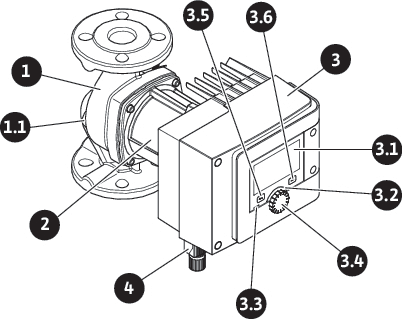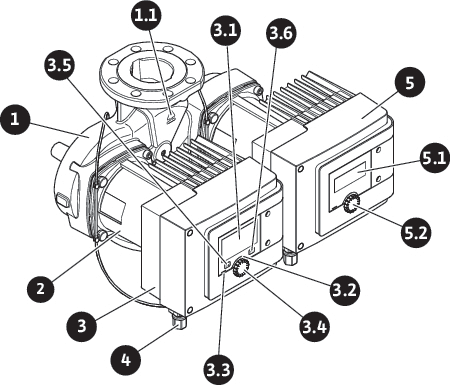Description of the pump
The Stratos MAXO smart-pumps, in threaded pipe union or flange connection versions, are glandless pumps with a permanent magnet rotor.


Pos. | Name | Explanation |
|---|---|---|
1. | Pump housing | |
1.1 | Direction of flow symbol | The fluid should flow in this direction. |
2. | Motor | Drive unit |
3. | Control module | Electronic unit with graphic display. |
3.1 | Graphic display | Provides information about settings and pump status. Self-explanatory user interface for setting the pump. |
3.2 | Green LED indicator | LED lights up, pump supplied with power. There are no warnings and no faults. |
3.3 | Blue LED indicator | LED lights up, pump is externally controlled via an interface, e.g. by: • Bluetooth remote operation • Setpoint specification via analogue input AI 1 or AI 2 • Intervention of building automation via control input DI 1 / DI 2 or bus communication. - Flashes with active double pump connection |
3.4 | Operating button | Navigate menus and edit content by turning and pressing. |
3.5 | Back button | Menu navigation: • To go back to the previous menu level (briefly press once). • To go back to the previous setting (briefly press once). • To go back to the main menu (press once and hold for > 1 s once). Turns key lock on or off in combination with the context button > 5 s. |
3.6 | Context button | Opens the context menu with additional options and functions. Turns key lock on or off in combination with the back button > 5 s. |
4. | Wilo-Connector | Electrical plug for mains connection |
5. | Base module | Electronic unit with LED display |
5.1 | LED display | Indicates error code and Bluetooth PIN. |
5.2 | LED display operating button | Triggers the pump venting function when pressed. Turning is not possible. |
There is a control module (Fig. 1/2, pos. 3) on the motor housing, which controls the pump and provides interfaces. Depending on the chosen application or control function, speed, differential pressure, temperature or volume flow will be controlled.
For all control functions, the pump continuously adapts to the system’s changing power requirements.